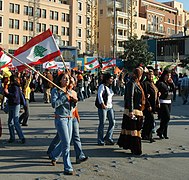Gender equality in Lebanon
This article, Gender equality in Lebanon, has recently been created via the Articles for creation process. Please check to see if the reviewer has accidentally left this template after accepting the draft and take appropriate action as necessary.
Reviewer tools: Inform author |
Lebanon has witnessed controlled attempts towards achieving gender equality. For example, Lebanon was a leading country in the middle east region and pioneered female rights to be enrolled in politics in 1953. Another important date in the Lebanese context to fight gender biases was 1996 where Lebanon endorsed the Convention on the Elimination all Forms of Discrimination Against Women (CEDAW).[1] One of the main reasons for this gap in promoting gender equality is attributed to the over all education policies in the country where the present curricula is irrelevant to advocate for gender equality. Adding to this, cultural concerns play a big role in this educational tendency of overshadowing gender equality where still females roles in society are viewed with a lot of biases and discriminations perceptions.[2]

History
Lebanon is considered as one of the most active countries in the middle east calling for women empowerment and gender equality both on the legal and societal levels. These attempts for change has been influenced by many conflicts and wars that took place within and around the country.[3] Discrimination is practiced among different sectors and professions and this gap differs from one sector to another.[4] Culture plays a big role in widening the gender gap in Lebanon.[5]
Gender Equality and Education
The UNDP and other partners of UN global community made gander equality a major concern within the Lebanese context. There was an increase number of female enrollment in primary education compared to what it was like 15 years ago. Females today represent around 41 percent of paid employees in different industries.[6]
Activity Gallery
- Women engagement in Lebanon
References
- ^ Melki, Jad; Mallat, Sarah (2013), Byerly, Carolyn M. (ed.), "Lebanon: Women's Struggle for Gender Equality and Harassment-free Newsrooms", The Palgrave International Handbook of Women and Journalism, London: Palgrave Macmillan UK, pp. 432–448, doi:10.1057/9781137273246_31, ISBN 978-1-137-27324-6, retrieved 2021-06-05
- ^ "Performance Management and Support Program for Lebanon(PMSPL II)". USAID Lebanon. 2019.
- ^ nanor (2020-02-28). "Setting the Agenda towards Gender Equity". Civil Society Knowledge Centre. Retrieved 2021-06-06.
- ^ Melki, Jad; Mallat, Sarah (2013), Byerly, Carolyn M. (ed.), "Lebanon: Women's Struggle for Gender Equality and Harassment-free Newsrooms", The Palgrave International Handbook of Women and Journalism, London: Palgrave Macmillan UK, pp. 432–448, doi:10.1057/9781137273246_31, ISBN 978-1-137-27324-6, retrieved 2021-06-06
- ^ "Can Women Speak Out in Lebanon?". iwpr.net. Retrieved 2021-06-06.
- ^ "Goal 5: Gender equality | UNDP in Lebanon". UNDP. Retrieved 2021-06-07.





